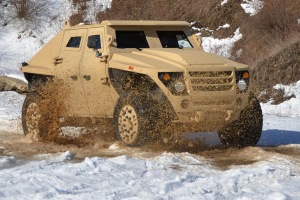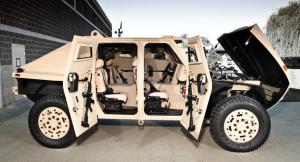Taken from Wandering American
New US Humvee Burns 70% Less Fuel
24 OctThe new vehicle, dubbed FED Alpha, will be on display this week in the Pentagon’s courtyard for an Energy and Sustainability Technology Fair. The vehicle has a solar panel on its back hatch to recharge its electrical systems, a custom engine and transmission along with several new features that will drastically increase its range and reliability over other models of Humvees. The new vehicle has all the toughness and survivability of the standard up-armored Humvee but burns 70% less fuel.
While the FED may not ever be mass-produced, it’s a valuable platform for testing the practical uses of environmentally friendly and sustainable technologies. The vehicle features a 200 horse-power 4 cylinder engine, a six speed automatic transmission and low-rolling resistance tires. The tires provide a 7% fuel reduction all by themselves. The savings from the tires alone are expected to save about $45 million annually if applied to the entire Humvee fleet. Their are several computer systems on board, such as one that informs the driver when they exceed the optimum fuel efficiency speed by causing the gas peddle to vibrate and giving resistance against more speed. However, if speed is essential to the mission, the driver just needs to push through the feedback.
Some other features of the FED are its high efficiency 28 volt integrated starter-generator that allows for extensive electronics to be installed, a light-weight aluminum structure except for the armored cab and v-shaped blast protection on the undercarriage. And finally, the FED has a much improved driveline specially designed to reduce friction.It’s been undergoing testing since July and another prototype design is under construction.
Interesting timeline of the vehicle in a PDF file here.
The End of the Aircraft Carrier
17 OctSince WW2, aircraft carriers have been the premier method of projecting power away from friendly shores. Bristling with weapons and boasting more planes than some countries have in their entire air forces, aircraft carriers can cost up to $15 billion to build and operate and are essentially massive floating fortresses. For decades the carrier has reigned as the undisputed master of the seas but now there are many factors that threaten it’s supremacy.
The first issue is the global financial crisis. Even though it seems like the worst is over, there is still a long recovery ahead before the world’s economic growth picks up. With austerity measures being put into place in several countries, defense spending is often the first expenditure on the chopping block. Carrier construction is a massive undertaking that is enough to bankrupt most countries and developed nations like the US, France, and the UK may soon have to decide between operating an expensive capital ship or paying bills.

The second issue is that no one country rules the seas anymore. The days of post-Cold War American dominance of the seas are almost at an end and new challengers are appearing. China, India, Russia, Brazil and others are in the process of constructing capable blue water navies, often employing advanced submarine fleets and missile ships, that may pose a serious danger to a lumbering carrier.
Another problem is that more effective counter-measures are being developed for the express purpose of limiting the effectiveness of carriers. The most notable counter-measure being China’s DF-21 missiles that can travel at low altitudes at supersonic speeds and can strike targets up to 900 miles away. This weapon was designed specifically for the purpose of checkmating American carrier groups in and around the East and South China Seas. As of now, there has yet be an effective way of combating the DF-21 and the US is check-mated for the time being. A $15 billion ship can be crippled or possibly even sunk by a missile that costs maybe $10 million at most.
What alternatives are there to hulking carriers? Simple. Less expensive helicopter carriers if you expect a need for amphibious operations. A small carrier loaded up with cheaper helicopter gunships could prove devastating in engagements that allow short range aircraft. Combat drones have also proven their effectiveness on the battlefield. Mid-sized mother ships that dispense endless waves of attack drones seem much more frightening and practical than a carrier loaded with a few dozen $120 million fighters. Sometimes sea-based aircraft aren’t even necessary. Look at Libya. Much of the naval force deployed was in the form of cruise missiles fired by submarines while sorties were flown from regional airbases with no real need for a carrier to be involved.
One could argue that the time of the carrier is not yet passed and that the numerous threats arising are just little bumps in the road. I agree that there will always be a need for a mobile platform that is able to provide an effective moving base of operations for aircraft but the risks of deploying these huge ships to unfriendly waters may soon outweigh the benefits. Unless counter-measures are found and implemented quickly and reliably as the new threats emerge then the fate of these titans of the sea remains murky.
McDonnell Douglas F-15 Eagle
14 OctThe F-15 is a twin engine tactical fighter capable of operating in any kind of weather conditions and was designed by the renowned McDonnell Douglas. Their design was selected in 1967 to give the US military a dominant air-superiority fighter, which would become one of the most successful fighters in modern times with over 100 aerial combat victories and no air-to-air losses. The F-15’s first flight was in July 1972. It went through rigorous trials and entered service in 1976 and is expected to remain in service with the US military until 2025. Since it’s production, the Eagle has also entered service with the armed forces of Saudi Arabia, Japan and Israel. Originally envisioned as a pure dogfighter, the F-15 has been further developed into 2 upgraded models. The F-15E Strike Eagle which is equipped with more advanced avionics and electronic warfare capabilities. The F-15SE is a stealthy version, complete with internal weapons bays and radar-absorbent materials.
The F-15 was developed in the F-X program of the late 1960’s in response to fears that the Soviet MiG-25 Foxbat could outclass current American fighters. McDonnell Douglas beat out heavy hitters like General Dynamics, Fairchild Republic and North American Rockwell to snatch up the lucrative fighter contract. The Eagle’s design incorporated the best aspects of older combat jet aircraft like the F-4 Phantom and combined it with the best in new technology and advanced designs like the “look down/shoot down” radar that could distinguish low-flying targets from ground clutter, a new canopy that provided unparalleled visibility, and all-new avionics and computer information systems.
Being the first strictly air-superiority fighter developed by the US since the F-86 Sabre from the late 1940’s, the production of the F-15 also required an overhaul in the design of advanced air-t0-air weaponry. The revolutionary canopy and heads up display allowed the single pilot to conduct air combat and fly the plane as safely and effectively as possible. It can be outfitted with several types of missiles including the Sparrow, AMRAAM, or Sidewinder. It also features an internal M61A1 20 mm Gatling gun under the right wing.
The Eagle has seen extensive combat use, mostly by Middle-Eastern militaries in regional conflicts. The first air-to-air kill was scored by an Israeli Air Force ace in 1979 and during Israeli raids into Lebanon in 1979-81, F-15As shot down 13 Syrian MiG-21 Fishbeds and 2 Syrian MiG-25 Foxbats. F-15s served in the 1982 Lebanon War where they shot down 40 enemy planes, 23 Syrian MiG-21 Fishbeds, 17 MiG-23 Floggers and 1 Syrian SA.342L Gazelle helicopter. In 1984, Saudi F-15C pilots shot down 2 Iranian F-4E Phantoms. In 1985, F-15s were used in a ground attack role to bomb a PLO headquarters in Tunisia. Saudi pilots shot down 2 Iraqi Mirage F1s during the Gulf War. The Eagle is also capable of being equipped with a satellite killer missile and has performed numerous successful tests. The USAF deployed F-15C, D, and E models to participate in the First Gulf War where they accounted for 36 of the 39 aerial victories. As of 2008, the aerial combat record for the F-15 from all operators stands at 104 kills and 0 air combat losses.
Number built: 1,198
Unit Cost: F-15A/B: $27,900,000. F-15C/D: $29,900,000
General characteristics
- Crew: 1: pilot
- Length: 63 ft 9 in (19.43 m)
- Wingspan: 42 ft 10 in (13.05 m)
- Height: 18 ft 6 in (5.63 m)
- Wing area: 608 ft² (56.5 m²)
- Airfoil: NACA 64A006.6 root, NACA 64A203 tip
- Empty weight: 28,000 lb (12,700 kg)
- Loaded weight: 44,500 lb (20,200 kg)
- Max takeoff weight: 68,000 lb (30,845 kg)
- Powerplant: 2 × Pratt & Whitney F100-100 or −220 afterburning turbofans
- Dry thrust: 17,450 lbf (77.62 kN) each
- Thrust with afterburner: 25,000 lbf for −220 (111.2 kN for −220) each
- Fuel capacity: 13,455 lb (6,100 kg) internal
Performance
- Maximum speed:
- High altitude: Mach 2.5+ (1,650+ mph, 2,660+ km/h)
- Low altitude: Mach 1.2 (900 mph, 1,450 km/h)
- Combat radius: 1,061 nmi (1,222 mi, 1,967 km) for interdiction mission
- Ferry range: 3,450 mi (3,000 nmi, 5,550 km) with conformal fuel tanks and three external fuel tanks
- Service ceiling: 65,000 ft (20,000 m)
- Rate of climb: >50,000 ft/min (254 m/s)
- Wing loading: 73.1 lb/ft² (358 kg/m²)
- Thrust/weight: 1.12 (−220)








